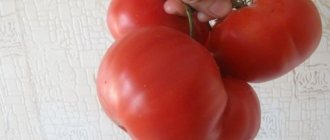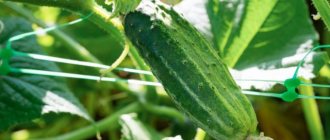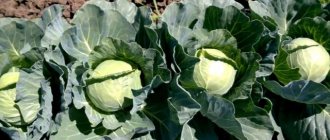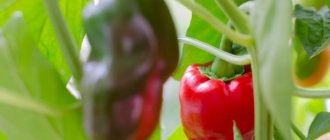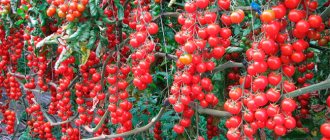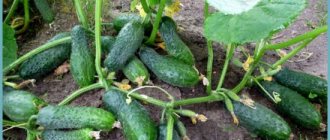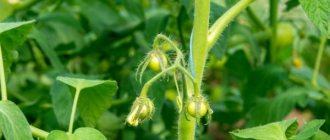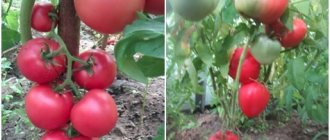Description of the hybrid
The crop is late-ripening, the roots are suitable for long-term storage. Sweet vegetables are rich in carotene, therefore valuable for baby and medical nutrition.
Origin and development
Sankina Lyubov carrots were bred by Moscow agro breeders for cultivation in risky farming regions, including the Urals and Siberia. Vegetable growers cultivate the hybrid throughout Russia.
Sanka’s love was not included in the State Register of the Russian Federation.
Composition and beneficial properties
Root vegetables contain important macro- and microelements for humans:
| Substance name | Contents per 100 g of product | Beneficial features |
| Potassium | 320 mg | Necessary for intracellular metabolism and normalization of water balance. |
| Sodium | 69 mg | Together with potassium, it maintains acid-base and water balances and is necessary for muscle contractions. |
| Phosphorus | 35 mg | Important for bones, teeth, muscles, heart function, kidneys. Participates in energy metabolism and transmission of nerve impulses. |
| Calcium | 33 mg | Forms the basis of bones and teeth. Participates in the conduction of neuromuscular impulses, regulates hormonal activity. |
| Magnesium | 12 mg | Stimulates the digestive system, supports the functioning of the heart, muscles, and nervous system. Has vasodilating properties. |
| Manganese | 0.1 mg | Important for the immune and reproductive systems. Participates in neurochemical processes. |
| Aluminum | 320 mcg | Forms tissues of the musculoskeletal system and skin in combination with other microelements. |
The main value of the hybrid is the increased content of carotene in root vegetables: up to 9 mg per 100 g. Once in the body, it is converted into vitamin A, which is especially important for the growth of a child’s body. Beta-carotene has antioxidant properties.
Interesting! In ancient Rome, carrots were considered a sacred plant: it was both a crunchy treat and a natural medicine. The composition of root vegetables includes carotenoids, vitamins, carbohydrates, essential oils, and mineral salts.
Vitamin composition of carrots:
| Name | Contents per 100 g of product | Beneficial features |
| B vitamins: thiamine, riboflavin, pantothenic acid, pyridoxine, folic acid | 30 mg | Support immunity, normalize the functioning of the cardiovascular and nervous systems. Improves skin condition and intestinal function. Protect the body from stress and prevent muscle cramps. |
| Vitamin C | 5.1 mg | Strong antioxidant. Fights inflammatory processes, strengthens the immune system. |
| Vitamin E | 0.6 mg | Supports the reproductive system, participates in metabolic processes. |
Ripening time and yield
Sanka's love is a late-ripening carrot. Root crops reach biological maturity 120–135 days after mass germination.
The hybrid is high-yielding: 5 kg of carrots are dug from 1 m2. At the same time, high productivity is ensured even on clay soils.
Disease resistance
With excessive watering, stagnation of water in the soil and dense plantings, the hybrid is susceptible to fungal diseases:
- white rot;
- black scab;
- brown spot;
- dry and black rot.
Diseases appear during crop cultivation and storage.
Important! A guarantee of healthy root crops is liming the soil before sowing.
Characteristics
Sanka's love is a cold-resistant hybrid that is not demanding on the soil. Root vegetables do not break or crack.
They have an attractive presentation: the tip is blunt, the core is not expressed, the shape is cylindrical, length - 20–25 cm, width - 3 cm, bright orange color, thin skin. Weight of vegetables - 90–120 g. Juicy, crispy, sweet root vegetables are universal in use.
The plant does not bolt and does not bloom. Carrots do not lose their taste until spring. It is planted both before winter and in spring.
Growing regions
The hardy hybrid is in demand throughout Russia. It is suitable for cultivation both in the middle zone and in cold regions of the Urals and Siberia. There are no special climate requirements.
About the best varieties of carrots for both winter sowing and seasonal cultivation
carrots sowing autumn winter sowing
10.11.2020
Sanka's love F1
Hybrid SANKINA LYUBOV is a completely new “round” in selection. Carrots have already won the hearts of thousands of gardeners, and 100 percent will become your favorite for many, many years.
The hybrid has a late ripening period and is therefore ideal for long-term storage. You will be amazed at how good SANKINA LOVE F1 is for these purposes: it does not rot, retains marketability, juiciness and taste for a very long time, almost until the next harvest.
The root crop is blunt-ended, maximum length 25 cm. Very often, when carrots are removed from the soil, they break. Just not the hybrid SANKINA LYUBOV, which in this regard is really strong and does not crack.
The root vegetable is incredibly tasty, sweet, juicy, ideal fresh, in salads, for canning and making juice, which turns out divine, and you don’t even need to add additional sugar. It is known that the quality of carrots is higher when it has more bark and less core, but SANKA'S LOVE F1 has practically no core.
SANKINA LOVE F1 causes a pleasant shock with its appearance - it grows even, smooth (no “deep folds”), and has a correctly defined shape. The peculiarity of the hybrid is that the tops of the plant are insignificant, and the root crop is gorgeous! And the harvest is always, regardless of weather conditions, mega-large.
SANKINA LYUBOV F1 is a miracle hybrid that deserves the highest praise! Be sure to try it!
Semenovna F1
SEMYONOVNA F1 – a true beauty! A new, modern hybrid, preferred by a huge army of gardeners. And you will surely become a fan of this orange miracle.
Carrots are mid-season and impress with their results even in the leanest year. Therefore, for areas of risky farming there is no better solution. But what amazes me even more is the quality of the root vegetables, which are so beautiful and appetizing that I could eat them all at once!..
The shape of carrots is cylindrical, they are even, as if drawn with a ruler, smooth (they have neither a “beard” nor lateral roots), and grow up to 18-20 cm in length. And, of course, root vegetables taste delicious.
SEMYONOVNA F1 is crispy, super-sweet, juicy, large - the dream of any gardener. The culture is resistant to the formation of flower stalks. Root vegetables have high commercial characteristics and can be stored for a long time, retaining all their taste and appearance properties.
To get early production, winter sowing is best done in late October-early November. And then you will be with SEMYONOVNAYA F1 for almost the entire season!
Sugar giant
Of the late-ripening varieties, SUGAR GIANT is the best in all respects. Productivity is “excellent”: so many root crops are born that even experienced gardeners are always surprised by their quantity. The crop demonstrates high productivity even under unfavorable weather conditions.
The quality of the fruit is the highest: carrots grow large - 25-27 cm in length, have an elongated cone shape with a slightly pointed “nose”, have a red-orange color, a smooth surface, and the most valuable thing is a small core.
The taste is amazing: the root vegetable is very juicy, very sweet, very tender! The kids will appreciate it, and the carrot bed will instantly be empty, so if you want to have enough for salads and other dishes, sow more.
SUGAR GIANT is endowed with resistance to flowering and diseases. Excellent storage throughout the winter. So the sweet crunch is guaranteed for a long time.
Turkish Delight
TURKEY LOKUM – sweeter than sweet! You’ve definitely never eaten such delicious, honey-candy, juicy, crispy carrots! A wonderful high-yielding variety, which is considered unsurpassed in terms of the presence of sugar in root crops.
Carrots have a cylindrical shape and a blunt tip, grow 16-18 cm in length. They are valued not only for their juiciness and sweetness, but also for their small core, which indicates the high quality of the root vegetable. The carrot pulp is red-orange in color, crispy, containing a large amount of juice and high levels of carotene.
TURKEY LOKUM does not crack and is resistant to discoloration.
The uniqueness of the variety is also that the rich harvest is perfectly stored until new. Carrots have excellent marketability and keeping quality, and even in late spring they are like fresh carrots: sweet, tasty, crunchy.
Purees and juices from such carrots are simply amazing. And crunching a delicious root vegetable is a separate issue: an excellent replacement for lamb candy!
Red Star ® F1
RED STAR ® F1 – a selection miracle. Everything about it is perfect and one can hardly wish for more. The root crop is mid-season, cylindrical in shape with a blunt end. Carrots are red-orange, which indicates a high content of carotene and sugars, and do not have a core, and this is indicator No. 1, indicating the quality of the plant.
RED STAR ® F1 will amaze with its correct shape: the root crop is even, smooth, large – 20-25 cm and weighing 140-180 g; and excellent taste - you won’t find anything sweeter and juicier. This is why hybrid purees and juices turn out incredibly tasty, and you don’t even need to add sugar. And, of course, add carrots to fresh vegetable mixes, prepare dishes from them, freeze them... The RED STAR ® F1 harvest is always excellent, so there is enough for all your endeavors.
One of the important properties of RED STAR ® F1 is that it is perfectly stored, does not spoil, does not become flabby, maintaining its appearance and excellent taste almost until the next harvest. Productive, tasty, shelf-stable - what else do you need? RED STAR ® F1 – for the garden: with vitamins all year round!
Advantages and disadvantages
Advantages of a hybrid:
- high productivity;
- large root vegetables that are not prone to cracking;
- undemanding to soil and climate;
- lack of tendency to flowering and bolting;
- good keeping quality of the crop;
- increased carotene content;
- excellent taste of carrots (highest rating on a five-point scale);
- versatility in cooking;
- Possibility of inclusion in children's and medical diets.
The main disadvantage is susceptibility to fungal diseases and pest attacks.
Differences from other varieties
The peculiarity of the hybrid is that it produces a high-quality harvest even on heavy soils. The root vegetables themselves can be stored for up to 10 months without loss of presentation and taste. The increased content of sugar and carotene makes vegetables indispensable for baby food.
Advantages and disadvantages
Evaluating the hybrid Sanka's love, gardeners almost unanimously come to the conclusion that this carrot consists of only advantages.
- Indeed, a hybrid is distinguished by:
- ultra-high yield;
- excellent taste characteristics;
- rich chemical composition with a very high content of sugar and carotene;
- universal purpose and the possibility of inclusion in children's and medical diets;
- unpretentiousness to soil composition;
- large root vegetables of regular shape and uniform size;
- frost resistance;
- lack of tendency to bolting, blooming, cracking;
- low losses during harvesting;
- good transportability;
- very long shelf life.
The hybrid has no objective disadvantages. We can say that carrots take quite a long time to ripen, but it is precisely this quality that provides root crops with good shelf life. In addition, any gardener must understand that high-yielding varieties and hybrids usually have higher requirements for the presence in the soil of all the nutrients necessary for their development and compliance with other agrotechnical conditions, without which you cannot count on the opportunity to enjoy all the above benefits.
Read the description of the seeds of the best varieties of carrots.
Features of planting and growing
Sankina Lyubov carrots are planted both in autumn and spring. Winter sowing in late October or early November allows you to get an earlier harvest for quick consumption, and the winter crop is planted in the spring.
Preparing for landing
Hybrid seeds do not require pre-sowing treatment. Dry grains are placed in the ground for both winter and spring sowing.
The bed is prepared in the fall: it is cleared of plant remains and dug up. The composition of the soil will improve if you sow green manure in the fall and dig up the soil again in the spring.
Soil requirements
The ideal soil for carrots is loam or sandy loam. If desired, clay soil is fertilized with a mixture of peat and sand at the rate of 10 liters per 1 m2.
Important! Fresh organic fertilizers are not applied before planting, otherwise the root crops will become deformed.
Predecessors
The vegetable is grown in the area where the following were previously grown:
- potato;
- cabbage;
- cucumbers;
- onion;
- corn;
- tomatoes.
After dill, parsley, celery, zucchini and other varieties of carrots, the crop is not planted in order to avoid possible diseases.
Dates, scheme and rules of planting
Sowing in spring is carried out in late April - early May, in autumn - in late October - early November. In the northern regions, carrots are planted 1-2 weeks later.
The row spacing is 20 cm. Furrows are dug 1.5–2 cm deep and watered generously. Then the seeds are laid out and sprinkled with earth. To preserve moisture, the bed is covered with transparent plastic film.
Reference. Some gardeners compact the plantings with their hands to prevent the seeds from being blown away in strong winds.
Features of cultivation
Sanka’s love needs certain conditions, which are created at the stage of choosing a suitable place. For carrots, a sunny, open area is suitable, next to onions and garlic. These crops repel pests. The surface of the bed is leveled and good drainage is provided so that excess liquid does not accumulate.
After the first shoots appear, the film is removed after 2-3 weeks. Caring for carrots involves regular watering, loosening, weeding, fertilizing and pest control.
Watering mode
Carrots are a moisture-loving plant. Irrigate it every 2-3 days. While the sprouts are small, the intensity of watering is low. As the root crops grow, the amount of water is increased so that the soil is saturated with moisture to a depth of 15–20 cm.
To improve the taste of vegetables, increase the sugar level in them and extend their shelf life, watering is stopped a month before harvest.
Attention! When watering, use only warm, settled water.
Thinning and weed control
To obtain large and even root crops, carrots are thinned 2-3 times per season. When the height of the tops reaches 4–6 cm, remove excess seedlings, leaving 3–4 cm between plants. The procedure requires care and precision. Experienced gardeners use tweezers. Repeated thinning is carried out a month after the first, removing excess plants and increasing the distance between them to 5–8 cm.
Weeds - a source of unwanted microorganisms that take away nutrients from the crop - are removed from the ground as they appear.
Top dressing
Sanka's love does not require frequent feeding. A month after germination, it is enough to add mineral products containing nitrogen, potassium and phosphorus. The classic version of this additive is “Nitrophoska”, diluted in a concentration of 1 tbsp. l per 10 liters of water.
2.5 months after the emergence of seedlings, the plantings are watered with a solution of wood ash (1 tbsp. dry matter per 10 liters of water).
Disease and pest control
Fungal diseases at an early stage are treated with biological preparations: “Fitosporin”, “Phytodoctor”, “Trichodermin”. At a late stage, the affected plants are removed, and the rest are sprayed every 2 weeks with the Kuproksat fungicide until signs of the disease are completely eliminated.
The main damage to carrots is caused by pests:
- carrot fly;
- wireworm;
- slug;
- mole cricket;
- aphid;
- scoop.
To combat them, insecticides are used: “Inta-Vir”, “Fas”, “Mukhoed”.
Important! Avoiding stagnation of water in the soil and timely weeding is the best prevention of damage to plantings.
Difficulties in growing and recommendations
There are few difficulties when cultivating a hybrid:
- the complexity of thinning carrots, especially when shoots appear;
- control of fungal diseases and pests.
Advice from experienced vegetable growers:
- To protect plantings from carrot flies, marigolds and calendula are planted around the perimeter of the beds.
- Root vegetables are stored until spring without loss if they are first dipped in a clay mash and dried.
- If young carrots are periodically pulled up for immediate consumption, the remaining vegetables will have more room to grow.
Features of cultivation
It is important to follow certain agricultural cultivation techniques that will allow you to obtain a high-quality harvest.
Soil requirements
Sandy-loamy areas are suitable for carrots. The humus content should not exceed 4%, and the optimal acidity level (pH) should be between 6 and 7.
A good harvest can be obtained on peat soils formed after the swamps dried out. Clay areas are not suitable, as plants experience serious resistance there during growth. This results in malformed fruits.
Harvest and storage
Timely harvesting is a guarantee of its long-term preservation.
How and when to collect
Harvesting begins 120–135 days after emergence. If white roots have formed at the tips of the root vegetables, and the tops have turned yellow at the base, then the vegetables are ready for harvesting. To dig them up, choose a dry, warm day.
Harvesting is completed by mid-September, before the onset of the rainy season.
It is better to dig up carrots with a shovel rather than a pitchfork. After removal from the ground, the vegetables are cleaned of soil residues and the tops are cut at a height of 2 cm from the base. Completely healthy and whole root crops with a dense structure are selected for planting.
Storage features and shelf life of the hybrid
Before storing, carrots are dried for 24 hours in a dark place. Next, they are placed in wooden boxes in layers, sprinkled with a 2-3 cm layer of sand. They are kept in a cellar or basement at a temperature of +2...+4°C and air humidity up to 98%.
If the correct storage conditions are met, vegetables will last until next spring and even summer.
Reviews
Gardeners speak positively about the hybrid, noting its resistance to weather conditions, immunity to diseases subject to the rules of agricultural technology, and its sweet taste.
Margarita, St. Petersburg: “ For the fifth year now I have been growing Sanka’s love because of the sweet and juicy taste of the root vegetables. The grandchildren crunch with pleasure. The fruits are smooth, never cracked or got sick. Even the rainy summer did not affect the harvest.”
Olga, Sysert: “The hybrid is good, there are no problems with cultivation and storage. I use mineral fertilizers and water infrequently. I thin out 2-3 times during the summer. I’m happy with the harvest, I recommend it to everyone.”
